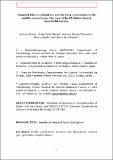Por favor, use este identificador para citar o enlazar a este item:
http://hdl.handle.net/10261/123669COMPARTIR / EXPORTAR:
 SHARE SHARE
 CORE
BASE CORE
BASE
|
|
| Visualizar otros formatos: MARC | Dublin Core | RDF | ORE | MODS | METS | DIDL | DATACITE | |

| Título: | Temporal lobe sulcal pattern and the bony impressions in the middle cranial fossa: The case of the El Sidrón (Spain) neandertal sample |
Autor: | Rosas, Antonio ; Peña-Melián, Ángel; García-Tabernero, Antonio CSIC ORCID; Bastir, Markus CSIC ORCID ; De la Rasilla, Marco | Fecha de publicación: | 19-jun-2014 | Editor: | John Wiley & Sons | Citación: | Anatomical Record - Advan in Integr Anatomy and Evol Biology 297(12): 2331-2341 (2014) | Resumen: | © 2014 Wiley Periodicals, Inc. Correspondence between temporal lobe sulcal pattern and bony impressions on the middle cranial fossae (MCF) was analyzed. MCF bone remains (SD-359, SD-315, and SD-1219) from the El Sidrón (Spain) neandertal site are analyzed in this context. Direct comparison of the soft and hard tissues from the same individual was studied by means of: 1) dissection of two human heads; 2) optic (white light) surface scans; 3) computed tomography and magnetic resonance of the same head. The inferior temporal sulcus and gyrus are the features most strongly influencing MCF bone surface. The Superior temporal sulcus and middle temporal and fusiform gyri also leave imprints. Temporal lobe form differs between Homo sapiens and neandertals. A wider and larger post-arcuate fossa (posterior limit of Brodmann area 20 and the anterior portion of area 37) is present in modern humans as compared to neandertals. However other traits of the MCF surface are similar in these two large-brained human groups. A conspicuous variation is appreciated in the more vertical location of the inferior temporal gyrus in H. sapiens. In parallel, structures of the lower surface of the temporal lobe are more sagittally orientated. Grooves accommodating the fusiform and the lower temporal sulci become grossly parallel to the temporal squama. These differences can be understood within the context of a supero-lateral deployment of the lobe in H. sapiens, a pattern previously identified (Bastir et al., Nat Commun 2 (2011) 588-595). Regarding dural sinus pattern, a higher incidence of petrosquamous sinus is detected in neandertal samples. | URI: | http://hdl.handle.net/10261/123669 | DOI: | 10.1002/ar.22957 | Identificadores: | doi: 10.1002/ar.22957 e-issn: 1932-8494 issn: 1932-8486 |
| Aparece en las colecciones: | (MNCN) Artículos |
Ficheros en este ítem:
| Fichero | Descripción | Tamaño | Formato | |
|---|---|---|---|---|
| AnatRecord 297(12) 2331-2341 (2014).pdf | 155,22 kB | Adobe PDF |  Visualizar/Abrir |
CORE Recommender
SCOPUSTM
Citations
10
checked on 21-abr-2024
WEB OF SCIENCETM
Citations
11
checked on 18-feb-2024
Page view(s)
279
checked on 26-abr-2024
Download(s)
321
checked on 26-abr-2024
Google ScholarTM
Check
Altmetric
Altmetric
Este item está licenciado bajo una Licencia Creative Commons

